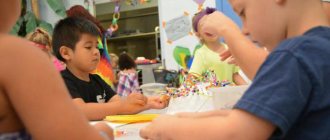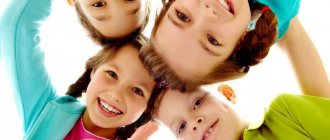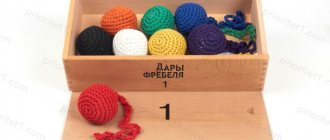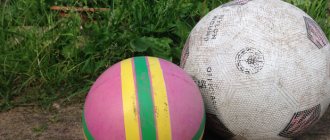Technologies for preserving and promoting children's health.
Contained in sections:
Includes sections:
- Articulation. Articulation gymnastics 1606
- Bioenergoplastics in working with children 127
- Gardenotherapy 7
- Gymnastics for the eyes. Visual gymnastics 427
- Gymnastics after sleep. Awakening gymnastics, wake-up 938
- Breathing gymnastics and exercises 1329
- Hardening of children 1296
- Play therapy. Play therapy 1949
- Kinesiology. Kinesiological exercises and games for children 469
- Lithotherapy, stone therapy 9
- Neuropsychological games, exercises, activities 221
- Posture. Forming correct posture 591
- Finger games, exercise equipment, gymnastics 3404
- Flat feet. Prevention, games and exercises 454
- Psycho-gymnastics, relaxation. Relieving emotional stress 666
- Daily routine 67
- Self-massage, play massage in kindergarten 2097
- Fairytale therapy. Education with a fairy tale 2072
Showing publications 1-10 of 4218. All sections | Health-saving technologies in preschool educational institutions
New
Photo
The best
Master class for educators “Bioenergoplasty - health-saving technology in preschool educational institutions” Bioenergoplasty - health-saving technology in preschool educational institutions It is no secret that the number of children with disabilities is currently growing, including children with severe speech impairments. And therefore, for educators, the creation of an optimal system is of particular relevance...
Art therapy as a health-saving technology in preschool educational institutions
Art therapy is a rather soft and flexible method of psychotherapy that helps to reveal suppressed emotions and unleash the child’s creative potential. Art therapy correction shows good results, despite its simplicity. This method promotes self-expression and...
Types of health-saving technologies in preschool education and their useconsultation
Consultation
"Types of health-saving technologies in preschool education and their use."
Prepared by the teacher of MBDOU "D/s No. 22", group No. 4 Blinova T.V.
Health-saving technologies in preschool education are technologies aimed at solving the priority task of modern preschool education - the task of preserving, maintaining and enriching the health of the subjects of the pedagogical process in kindergarten: children, teachers and parents.
Types of health-saving technologies in preschool education:
- medical and preventive;
- physical education and recreation;
- technologies to ensure the socio-psychological well-being of the child;
- health preservation and health enrichment for preschool teachers;
- health-saving educational technologies in kindergarten;
- technologies for valeological education of parents.
Medical and preventive technologies in preschool education are technologies that ensure the preservation and enhancement of children’s health under the guidance of medical personnel of preschool educational institutions in accordance with medical requirements and standards, using medical supplies. These include the following technologies: organizing monitoring of the health of preschool children and developing recommendations for optimizing children's health; in-depth medical examination with the participation of narrow specialists coming from the clinic, correction of emerging functional abnormalities, monitoring the nature of the course of chronic pathology, rehabilitation of somatic health status; organization and control of nutrition for children of early and preschool age, physical development of preschool children, hardening; organization of preventive measures in kindergarten; organization of control and assistance in meeting SanPiN requirements; organization of a health-preserving environment in preschool educational institutions, vitamin prophylaxis.
Physical education and health technologies in preschool education are technologies aimed at physical development and strengthening the health of the child: the development of physical qualities, motor activity and the formation of physical culture of preschoolers, hardening, breathing exercises, massage and self-massage, prevention of flat feet and the formation of correct posture, health procedures in aquatic environment (swimming pool) and on exercise equipment, developing habits of daily physical activity and health care, sports entertainment and leisure, health weeks, competitions, walks, hikes, etc. The implementation of these technologies is usually carried out by physical education specialists and educators Preschool educational institutions in the conditions of specially organized forms of recreational work. Certain techniques of these technologies are widely used by preschool teachers in various forms of organizing the pedagogical process: during classes and walks, during restricted moments and in the free activities of children, during pedagogical interaction between an adult and a child, etc.
Technologies for the socio-psychological well-being of a child are technologies that ensure the mental and social health of a preschool child. The main task of these technologies is to ensure emotional comfort and positive psychological well-being of the child in the process of communicating with peers and adults in kindergarten and family, ensuring the social and emotional well-being of the preschooler. The implementation of these technologies is carried out by a psychologist through specially organized meetings with children, as well as teachers and preschool education specialists in the current pedagogical process of preschool educational institutions. This type of technology includes technologies for psychological and psychological-pedagogical support of child development in the pedagogical process of preschool educational institutions. In middle groups, a complex of projective techniques and tests is used individually with each child:
- identifying the state of the child’s emotional sphere, as well as the presence of aggression, its direction and intensity,
- identifying the child’s system of ideas about how he evaluates himself, how, in his opinion, other people evaluate him, and how these ideas relate to each other,
- projective technique “Family Drawing” to identify features within family relationships.
Work with the older group is aimed at identifying fears and the level of anxiety in children (R. Tamml, M. Dorki, V. Amen). The use of a set of methods by K. Jirasik in the preparatory group for school allows us to identify psychological and intellectual readiness for school, school levels maturity, motivational readiness, and the “Ladder” test, designed to determine the child’s ideas about himself. To implement the technology of socio-psychological well-being and further successful adaptation of the child to school, training sessions are conducted with children aged 4-7 years. The classes provide opportunities for each child to discover their inner potentials and resources.
Technologies for health preservation and health enrichment of preschool teachers are technologies aimed at developing a culture of health for kindergarten teachers, including a culture of professional health, and developing the need for a healthy lifestyle. These include training seminars “Psychological health of teachers”; Consultations for teachers “Signs of fatigue in a preschool child”, “Prohibited physical exercises for preschool children”, “How to properly conduct gymnastics (various types) with preschoolers”, “Prevention of fatigue in preschool children in preschool educational institutions”, “The work of a teacher in the sections of the program “Fundamentals of Safety” and life activity of children”, etc.; workshop for teachers of preschool educational institutions “Techniques for relaxation and stress relief during the working day”; Discussion of health preservation issues at pedagogical councils and medical and pedagogical meetings in early age groups and correctional groups.
Health-saving educational technologies in kindergarten are, first of all, technologies for educating a valeological culture or a culture of health in preschoolers. The purpose of these technologies is to develop a child’s conscious attitude towards health and human life, accumulate knowledge about health and develop the ability to protect, support and preserve it, acquire valeological competence, allowing a preschooler to independently and effectively solve the problems of a healthy lifestyle and safe behavior, tasks associated with provision of basic medical and psychological self-help and assistance. In preschool pedagogy, the most significant types of technologies include technologies for personality-oriented education and training of preschoolers. The leading principle of such technologies is taking into account the personal characteristics of the child, the individual logic of his development, taking into account children's interests and preferences in the content and types of activities during upbringing and training. Construction of the pedagogical process with a focus on the child’s personality naturally contributes to his prosperous existence, and therefore health.
Educational activities involve conducting classes and conversations with preschoolers about the need to maintain a daily routine, the importance of hygienic and physical culture, about health and means of strengthening it, about the functioning of the body and the rules of caring for it, children acquire cultural and healthy lifestyle skills, knowledge of the rules of safe behavior and reasonable actions in unforeseen situations.
Technologies for valeological education of parents are technologies aimed at ensuring the valeological education of parents of preschool children and their acquisition of valeological competence. Valueological education of parents should be considered as a continuous process of valueological education of all family members. Technologies are used as follows:
- Information stands for parents: in each age group there are sections covering issues of health improvement without drugs (sets of exercises for the prevention of disorders of the musculoskeletal system, visual organs, for the development of general and fine motor skills, finger games);
- Information stands for medical workers about preventive medical work with children in preschool educational institutions;
- Involving parents in participating in physical culture events of preschool educational institutions (competitions, sports festivals, open days, health days and weeks, meetings of preschool educational institutions children with parent-athletes, etc.);
- Consultations and conversations with parents on health issues.
Possibilities of using health-saving technologies in preschool educational institutions.
In preschool educational institutions, health-saving technologies are most often used in the following areas (further we will talk about pedagogical health-saving technologies, which include all aspects of the teacher’s impact on the child’s health at different levels - informational, psychological, bioenergetic
1. Technologies for preserving and promoting health.
2. Technologies for teaching a healthy lifestyle.
3. Corrective technologies.
| Pedagogical health-saving technologies | ||
| Technologies for preserving and promoting health | Technologies for teaching healthy lifestyles | Corrective technologies |
| — Stretching — Dynamic pauses — Moving, round dancing and sports games — Relaxation — Gymnastics (finger, eye, breathing, etc.) — Dynamic, corrective, orthopedic gymnastics | — Physical education classes — Problem-based games: game training, game therapy — Communication games — Series of classes “Health Lessons” — Acupressure self-massage | — Technologies of musical influence — Art therapy — Fairy tale therapy — Color influence technologies — Psycho-gymnastics — Phonetic rhythm |
The choice of health-saving pedagogical technologies in a particular preschool educational institution depends on:
- type of preschool institution
- specific conditions of a preschool educational institution
- organizing a health-preserving environment
- from the program on which teachers work
- length of stay of children in preschool educational institutions
- on children's health indicators
- professional competence of teachers.
Recommendations for the use of health-saving pedagogical technologies in preschool educational institutions
Technologies for preserving and promoting health
Stretching (stretching) is a set of methods and exercises used to work on flexibility, which is interconnected with other important physical qualities - strength, speed, coordination. Performed no earlier than after 30 minutes. after meals, 2 times a week for 30 minutes. from middle age, in a physical education or music hall, or in a group room, in a well-ventilated room, special exercises to music. Recommended for children with sluggish posture and flat feet. Responsible executor: head of physical education, teachers. The exercises are performed slowly, smoothly, with a slight delay in each position. They improve posture, strengthen muscles, making them elastic, flexible, develop joints, contribute to the development of emotional balance, perseverance, and concentration in older preschoolers. It is important to emphasize the positive impact of joint stretching classes with children and parents in the afternoon, during which a strong motivation is formed for all participants in the pedagogical process to preserve and promote health. Playful stretching classes will help the child develop a sense of rhythm, strengthen muscles, straighten posture, and relieve inhibitions. Classes using the stretching technique are conducted in the form of a role-playing or thematic game, which includes 8–9 exercises for various muscle groups. Children pretend to be different animals and perform exercises accompanied by certain pieces of music from classical and folk music. Stretching exercises are imitative in nature and are performed during a role-playing game, consisting of interconnected game situations, tasks, exercises, selected in such a way as to facilitate the solution of health-improving and developmental tasks. By imitating the image, the child begins to learn the technique of movements in sports and dance exercises, games, theatrical activities, etc.
Outdoor games. In kindergarten, outdoor games are of great importance. Children satisfy their need for movement, communication with each other, and at the same time receive the information necessary for development. Precisely because this type of activity is an important part of the education process, every parent should know what kind of outdoor games are interesting to preschoolers. After all, this will help to use them at home. Round dance games. Round dance games have been loved in Rus' since ancient times. Not a single holiday would be complete without them. They develop a sense of rhythm and ear for music, help improve motor skills, attract children to each other, and liberate them.
Dynamic pauses (physical minutes). They entertain children, create an atmosphere favorable for learning, provide elements of relaxation, and relieve nervous tension from overload. They are also able to unobtrusively correct emotional problems in the child’s behavior, prevent psychological disorders, and promote overall health. Carry out during classes, 2-5 minutes, as children get tired. Recommended for all children as a preventive measure against fatigue. May include elements of eye exercises, breathing exercises and others, depending on the type of activity. Responsible executor: educators.
Outdoor and sports games, relay races - as part of a physical education lesson, on a walk, in a group room - low, medium and high degrees of mobility. Daily for all age groups. Games are selected according to the age of the child, the place and time of the game. In kindergarten we use only elements of sports games.
Responsible executor: head of physical education, teachers.
Relaxation - in any suitable room, depending on the condition of the children and goals, the teacher determines the intensity of the technology. For all age groups. You can use calm classical music (Tchaikovsky, Rachmaninov), sounds of nature. Responsible executor: head of physical education, educators, psychologist.
Finger gymnastics - is carried out to develop fine motor skills and for the entertainment of children, stimulates the development of fingers. Their regular use in the garden and at home also contributes to the development of a child’s memory, thinking, attention, and speech. Used from a young age individually or with a subgroup daily. Recommended for all children, especially those with speech problems. Conducted at any convenient time (at any convenient time). Responsible executor: educators, psychologist.
Eye exercises are necessary to preserve vision. We use eye exercises to prevent visual impairment, they relieve visual tension and strengthen the eye muscles. You can blink, ask to close your eyes, open your eyes wide and look into the distance. It is also interesting for children to follow the finger, which is either approaching the nose or moving away from it. Such health-saving technologies are used daily for 3-5 minutes when working with children. at any free time depending on the intensity of visual load from a young age. It is recommended to use visual material and demonstration by the teacher. Responsible person: all teachers
Breathing exercises. It is very important to pay attention to proper breathing. It is important that children breathe not shallowly, but deeply. The “train” exercise is well suited for breathing exercises. When walking, you need to make movements with your hands, depicting the ride of a train and at the same time pronounce words. It is also good to bend to the sides while inhaling and exhaling. “Clock” exercise: children stand up straight and begin to wave their arms back and forth, while saying “tick-tock.” Used in various forms of physical education and health work. Ensure the room is ventilated and the teacher give children instructions on mandatory nasal hygiene before the procedure. Responsible person: all teachers
Invigorating gymnastics (awakening hymn) – daily after nap, 5-10 minutes. . As a set of measures aimed at teaching a healthy lifestyle. These are exercises performed by children after a nap. You can perform these exercises on beds. This includes self-massage, walking on ribbed boards, stones, jogging from the bedroom to the playroom, in which a slight temperature difference is maintained. After such exercises, extensive washing with cool water is carried out. Such invigorating procedures allow the child’s body to quickly get into the working rhythm and improve his health. Responsible executor: educators.
Corrective gymnastics - in various forms of physical education and health work. The form of implementation depends on the task and the number of children. Responsible executor: head of physical education, teacher.
Orthopedic gymnastics – in various forms of physical education and health work. Recommended for children with flat feet and as a prevention of diseases of the supporting arch of the foot. Responsible executor: head of physical education, teacher.
Technologies for teaching a healthy lifestyle.
Morning exercises. Regular (daily) morning exercises (naturally, under the guidance of adults) gradually accustom the child to physical exercise and associate it with positive emotions, pleasant muscle sensations that only cause cheerfulness. Daily physical exercise helps children develop the habit of systematic morning exercises and the manifestation of volitional efforts.
Physical education – 2-3 times a week in a sports hall or music hall. Early age - in a group room, 10 min. Young age - 15-20 minutes, middle age - 20-25 minutes, older age - 25-30 minutes. Before class, it is necessary to ventilate the room well. Responsible executor: head of physical education, teacher.
Problem-based games (game training, game therapy) - in free time, possible in the afternoon. The time is not strictly fixed, depending on the tasks set by the teacher. The lesson can be organized unnoticed by the child, by including the teacher in the process of play activities. Responsible executor: educators, psychologist.
Communication games – 1-2 times a week for 30 minutes. from an older age. Classes are structured according to a specific scheme and consist of several parts. They include conversations, sketches and games of varying degrees of mobility, drawing, modeling, etc. Responsible person: educators, psychologist.
Classes from the series “Health Lessons” - once a week for 30 minutes. from an older age. Can be included in the lesson schedule as cognitive development. Responsible executor: educators, psychologist.
Self-massage. The main purpose of massage is to relieve nervous tension, general relaxation, and improve the functioning of internal organs and vital systems. Depending on the goals set by the teacher, in sessions or in various forms of physical education and health work.
It is necessary to explain to the child the seriousness of the procedure and give children basic knowledge of how not to harm their body. These are exercises such as: • rolling one walnut, ball or cone between the palms, • rolling a ribbed pencil,
• imitation of rolling a kolobok, sticks, as in modeling,
• squeezing rubber toys of different densities, etc.
Responsible executor: educators, art. nurse, head of physical education
Acupressure. It is carried out on the eve of epidemics, in the autumn and spring periods at any time convenient for the teacher from an older age. It is carried out strictly according to a special technique. Recommended for children with frequent colds and respiratory diseases. Visual material (special modules) is used. Responsible executor: educators, art. nurse, head of physical education.
Corrective technologies
Technologies of musical influence - music therapy. Music therapy as the holistic use of music as the main and leading factor in influencing the development of a child includes such areas as vocal therapy (singing, music therapy in movements), dancing, musical rhythmic games, playing music on musical instruments. Used in various forms of physical education and health work; or separate classes 2-4 times a month, depending on your goals. Used as an aid as part of other technologies; to relieve tension, increase emotional mood, etc. Responsible person: all teachers
Articular massage. Ear massage - articular - is used from a very early age. It helps to develop all body systems and improves intellectual abilities. Activates the work of all organs and systems of the body without exception. Apply daily.
Art therapy. As an independent method of art therapy, isotherapy relieves the nervous system, stimulates the development of motor skills, and calms the psyche. This method is one of the best ways to learn about the internal state of a child. In isotherapy, various materials are used: pencils, paints, plasticine, colored paper. Sessions of 10-12 lessons for 30-35 minutes starting from the middle group. The program has diagnostic tools and involves keeping training records. Responsible executor: educators, psychologist.
Articulatory gymnastics - used to form the correct pronunciation of sounds.
Logorhythmics. Logorhythmic exercises are carried out together with the music director. Perform movements with speech accompaniment. As a result, the child's speech improves.
Fairy tale therapy or “fairy tale treatment” is a new young trend in applied psychology, which is used by psychologists and teachers. The essence of fairy tale therapy is that a child or an adult composes a fairy tale that reflects the difficulties that the child has encountered, and then together they find ways to solve them. Conduct 2-4 classes per month for 30 minutes. from an older age. Classes are used for psychological therapeutic and developmental work. A fairy tale can be told by an adult, or it can be a group story, where the narrator is not one person, but a group of children, and the rest of the children repeat the necessary movements after the storytellers. Responsible executor: educators, psychologist.
Color influence technologies – as a special lesson 2-4 times a month, depending on the tasks. Correctly selected interior colors in a group relieve tension and increase the child’s emotional mood. Responsible executor: educators, psychologist.
Psycho-gymnastics – 1-2 times a week from older ages for 25-30 minutes. Aimed at the development and correction of various aspects of the child’s psyche.
Responsible executor: educators, psychologist.
Phonetic rhythmics - 2 times a week from a young age in physical education or music halls. Classes are recommended for children with hearing problems or for preventive purposes. Responsible executor: educators, speech therapist, head of physical education.
Health-saving technologies used in combination ultimately form a strong motivation in the child for a healthy lifestyle.
The use of health-saving pedagogical technologies in the work of preschool educational institutions will increase the effectiveness of the educational process, form value orientations among teachers and parents aimed at preserving and strengthening the health of pupils, if conditions are created for the possibility of adjusting technologies, depending on the specific conditions and specialization of the preschool educational institution.




